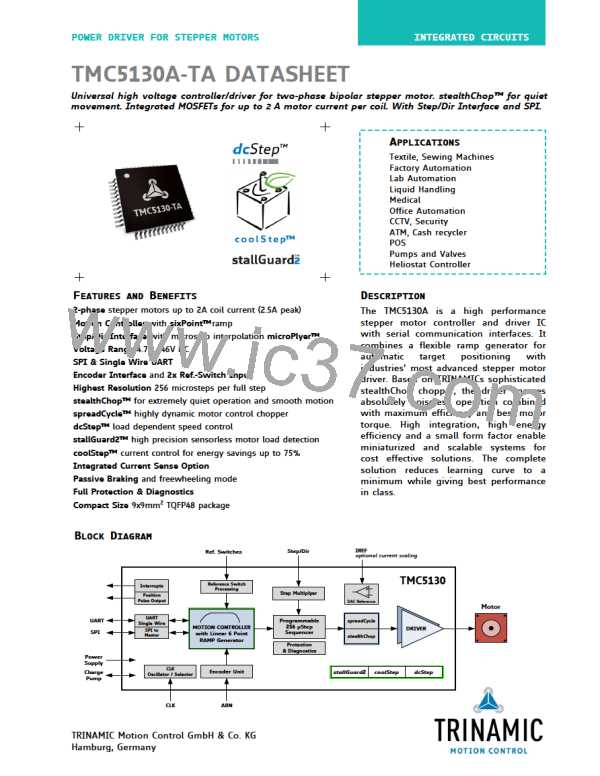TMC5130A DATASHEET (Rev. 1.14 / 2017-MAY-15)
7
1.1 Key Concepts
The TMC5130A implements advanced features which are exclusive to TRINAMIC products. These
features contribute toward greater precision, greater energy efficiency, higher reliability, smoother
motion, and cooler operation in many stepper motor applications.
stealthChop™ No-noise, high-precision chopper algorithm for inaudible motion and inaudible
standstill of the motor.
spreadCycle™ High-precision chopper algorithm for highly dynamic motion and absolutely clean
current wave.
dcStep™
Load dependent speed control. The motor moves as fast as possible and never loses
a step.
stallGuard2™
coolStep™
Sensorless stall detection and mechanical load measurement.
Load-adaptive current control reducing energy consumption by as much as 75%.
microPlyer™
Microstep interpolator for obtaining increased smoothness of microstepping when
using the STEP/DIR interface.
In addition to these performance enhancements, TRINAMIC motor drivers offer safeguards to detect
and protect against shorted outputs, output open-circuit, overtemperature, and undervoltage
conditions for enhancing safety and recovery from equipment malfunctions.
1.2 Control Interfaces
The TMC5130A supports both, an SPI interface and a UART based single wire interface with CRC
checking. Selection of the actual interface is done via the configuration pin SW_SEL, which can be
hardwired to GND or VCC_IO depending on the desired interface.
1.2.1 SPI Interface
The SPI interface is a bit-serial interface synchronous to a bus clock. For every bit sent from the bus
master to the bus slave another bit is sent simultaneously from the slave to the master.
Communication between an SPI master and the TMC5130A slave always consists of sending one 40-bit
command word and receiving one 40-bit status word.
The SPI command rate typically is a few commands per complete motor motion.
1.2.2 UART Interface
The single wire interface allows differential operation similar to RS485 (using SWIOP and SWION) or
single wire interfacing (leaving open SWION). It can be driven by any standard UART. No baud rate
configuration is required.
1.3 Software
From a software point of view the TMC5130A is a peripheral with a number of control and status
registers. Most of them can either be written only or read only. Some of the registers allow both read
and write access. In case read-modify-write access is desired for a write only register, a shadow
register can be realized in master software.
www.trinamic.com

 TRINAMIC [ TRINAMIC MOTION CONTROL GMBH & CO. KG. ]
TRINAMIC [ TRINAMIC MOTION CONTROL GMBH & CO. KG. ]